SMALLER IS BETTER
Small Plants
Weeding. Planting. Harvesting. Making compost. Spreading compost. Staking. Pruning. Mowing. These are some of the activities I share with my plants this time of year. But, as Charles Dudley Warner wrote in his 1870 classic, My Summer in a Garden, “Blessed be agriculture! If one does not have too much of it.” Which prompts me to weed, plant, harvest, etc. most efficiently.
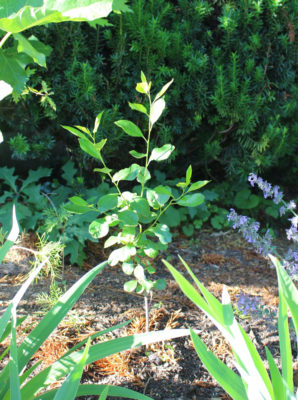
Bush cherry, 1 month after planting
Let’s take a look at some of the trees and shrubs I’ve planted this spring: Romeo and Carmen Jewel bush cherries, aronia, Grainger shellbark hickory, Great Wall Asian persimmon, Rosa canina, and Hidcote St. Johnswort. Just getting all those plants through their first season could entail lugging around many buckets of water. But it doesn’t.
Large plants of any of these could possibly be sourced but I chose small plants. And that was the first step to making sure that, paraphrasing C. W., I wasn’t overburdened with my agriculture.
With smaller root systems, small plants establish more quickly than large plants. In fact, establishing more quickly, smaller plants usually outgrow their larger counterparts after a few years.
A tree or shrub with a two-foot diameter root ball might require 3 gallons of water weekly until enough roots foraged out into surrounding soil to make the plant self-sufficient water-wise. Two cups of water weekly is enough to keep my newly planted Romeo bush cherry alive since its move from the 4-inch-diameter pot it previously called home.
By the end of this growing season, all these small plants will be firmly established and pretty much water independent. They’ll get supplemental water only if there’s any extended dry spells in their second season.
Small Planting Holes
Water for these young plants isn’t all about watering per se.
Site preparation is also important. Not that, as older gardening books used to suggest, it’s “better to dig a $50 hole for a $5 tree than a $5 hole for a $50 tree,” the dollar amounts reflecting the size of the tree and the hole. No need for such heroic measures. Digging that large a hole breaks up the capillary channels in a large volume of soil, leaving large air gaps in the soil through which water just runs down and out. Capillary channels can move water, down, up, and sideways.

Shellbark hickory, 1 mo. after planting
Better — and easier — is to dig a hole only twice as wide as the spread of the roots or root ball (if potted), and only as deep as needed so a plants sits at the same depth as it did its pot or the nursery.
With few exceptions, no need to add compost, peat moss, fertilizer, or anything else to the soil in the planting hole. After all, the expectation is for roots to eventually extend well beyond the planting hole. Create excessively posh conditions in the hole and roots have no incentive to leave. Then roots grow only in their planting hole, not beyond.
All soil goodies are best lathered on top of the ground. My first choice is for compost. Nutrients and beneficial soil organisms within the compost, over time, meld with the soil below. Compost also softens impact of raindrops so that water can percolate down into the ground rather than running off in rivulets — lessening my need for watering.
A mulch is the final icing on this layer cake. I’ll top the compost with wood chips, leaves, straw — any weed-free, organic material. This top layer further softens the impact of raindrops, keeps compost moist and vibrant, and slowly decomposes to nourish soil microorganisms and then the tree or shrub.
Yesternight’s rain or 1.25” did a week’s watering for me. A good rule of thumb is to apply one-inch of water once a week, or, equivalently, three-quarters of a gallon per estimated square foot spread of the roots. Potted trees and shrubs need that one-inch of water spread over 2 or 3 days of the week for a couple of weeks after being planted, until their roots begin to spread into surrounding soil. Larger tree and shrub transplants need more water, more frequently, for a longer period of time.
Followup on Drastic, and Less Drastic Pruning
I recently wrote of “renovating” my old lilac shrub, a no-brainer as far as pruning. You just lop each and every part of the plant right to the ground. My fears that such drastic pruning might also kill the plant were unfounded. Already, new sprouts are growing from the sawed off remains of the plant as well as from some distance away. All that’s needed now is to choose which sprouts to keep to grow into a whole new shrub.
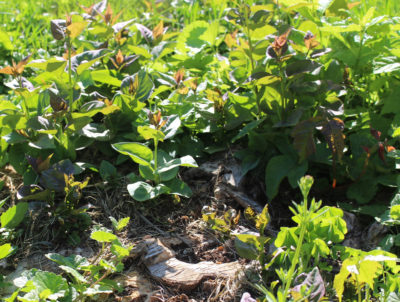
Lilac regrowth from stump
My blueberry shrubs also received more drastic pruning than usual. To lower their height and to encourage and make space for younger, more fruitful stems, I lopped a few of the oldest stems of each bush right to ground level. Like the lilac, new sprouts soon rose from ground level.
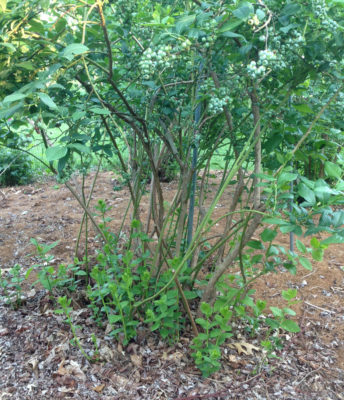
Blueberry, new sprouts
Late next winter, I’ll save the most vigorous of these new sprouts and lop the rest of them all the way to the ground. And, of course, again lop to ground level some of next year’s oldest stems.
Such pruning (covered in my book The Pruning Book) keeps blueberry and lilacs perennially renewed, without any stems that are too old to flower or fruit well as well as plenty, but not too many, young replacement stems for the future.

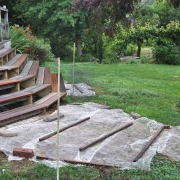
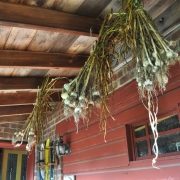

How long before the lilac bush will bloom again after renovating pruning?
My guess is 3 or 4 years. I’ll know for sure in 3 or 4 years.
Great Wall persimmon! I’m very excited to hear how that works for you in your zone. I know they are supposed to be one of the hardiest true Asian persimmons. I am surprised you haven’t tried the hybrids such as Nikita’s Gift or Rosseyanka (or maybe you have). I have planted both of those varieties along with Saijo and TamKam, but only within the last year. I’m in zone 7, central Virginia. I also planted Juliet bush cherry based on one of your blog posts earlier in the year.
I have a pear/fire blight question for you, if you don’t mind. I have planted two pear trees this spring, Potomac and Shin Li, knowing that there are also many ornamental pears close by for cross pollination. Well, wouldn’t you know it, I’ve noticed that all of the ornamental pears are riddled with fire blight strikes this year. Knowing that, is there any advice for success with my pears? Are pears just not in the cards for me in my location? Thanks for your great blog and books!
Pears vary a lot in their fireblight susceptibility. Both are somewhat resistant to the disease. Keep an eye out for fireblight and prune it away when you see it.
Hi Lee, I know small is good. But some things want to get big. I bought two Peterson Pawpaws, and they want to grow to 20-30 ft. Question: Can I prune them back, and just force them to say 8-12′ tall, and still expect a fair fruit crop? I need 2 for pollination, and have no room for 2 full grown pawpaws. Thanks.
Yes, they’re easy to keep small. I regularly lop off the tops to sturdy side branches and shorten branches to keep my trees from growing too wide. Just remember that fruit buds are produced on one-year-old wood. If you want them to take up even less space, graft a branch of one onto the other. Then after the graft takes, remove the tree from which you took the scion.
Nice idea. I bought 2 Peterson varieties. I’ll graft each onto the other, so each will be “self-fertile,” and I can have them a long ways apart with still good pollination. Any trick to grafting pawpaws, in terms of time of year, etc?
I use whip graft, bark graft, or cleft graft, doing it about when rootstocks begin to grow with previously collected scions held dormant under cool, moist conditions.
BTW, I bought 2 Peterson patented Pawpaws, which are said to have great taste and output. If those are my only pawpaws, and they cross pollinate and produce fruit, can I expect the SEEDS in that fruit to produce trees that have those same attractive features? Will the kids tend to look like mom and dad?
They might, or might not. It’s a crap shoot. With that said, though, many pawpaw seedlings have good flavor, a much higher proportion than apple seedlings.
Hello,
I just purchased your pruning book at a lovely little independent bookstore in Belfast, Maine. What a nice surprise to find it on the shelf! So much to learn.
Your books are excellent tools.
Thank you!